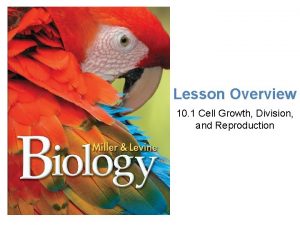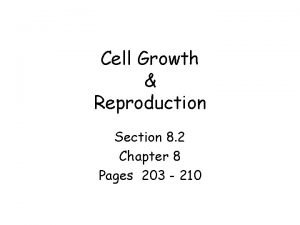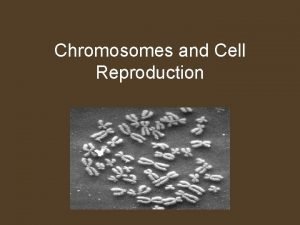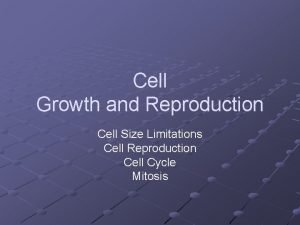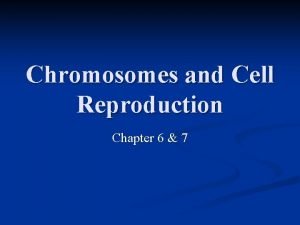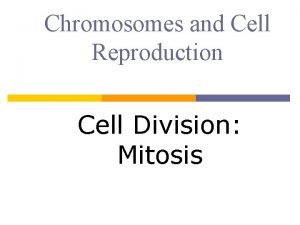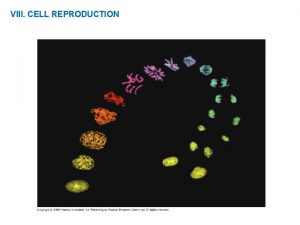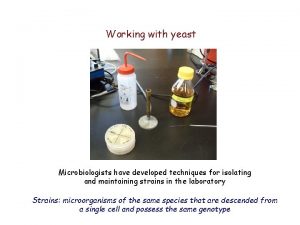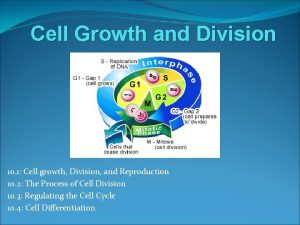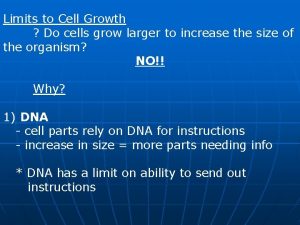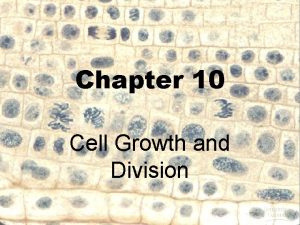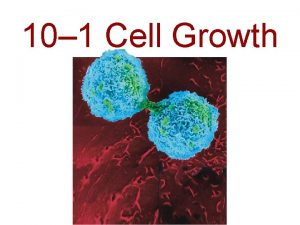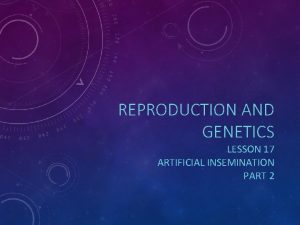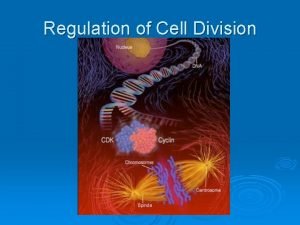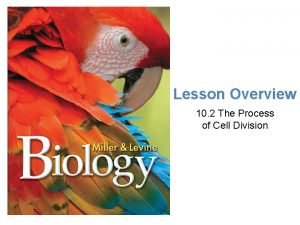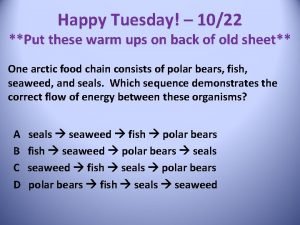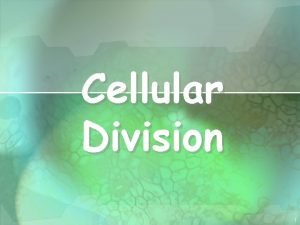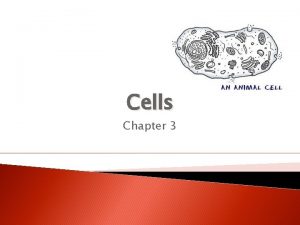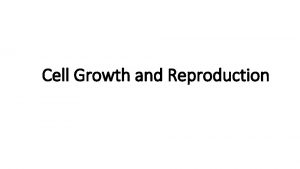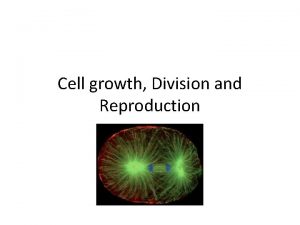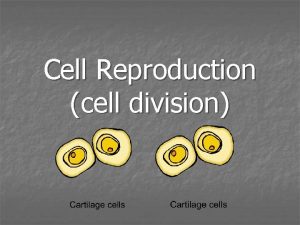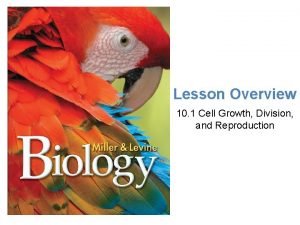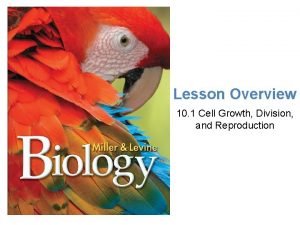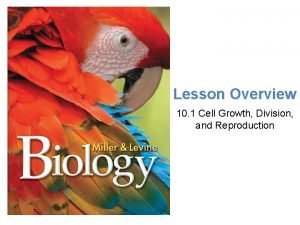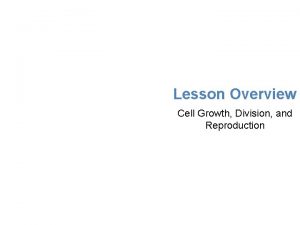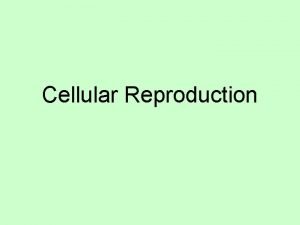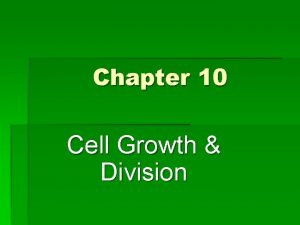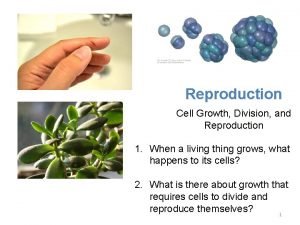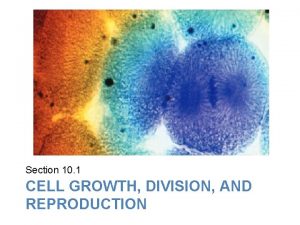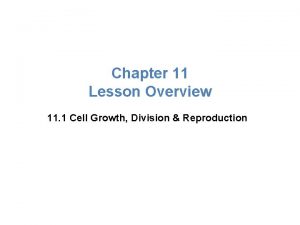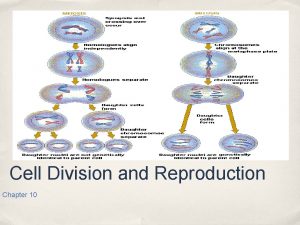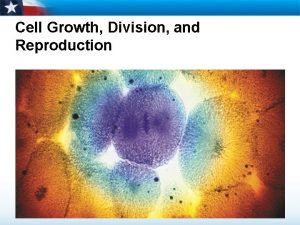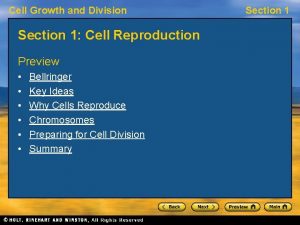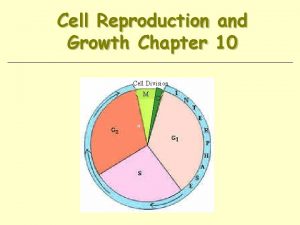Lesson Overview Cell Growth Division and Reproduction Lesson





























































- Slides: 61

Lesson Overview Cell Growth, Division, and Reproduction

Lesson Overview Cell Growth, Division, and Reproduction THINK ABOUT IT When a living thing grows, what happens to its cells? Why are cells so small? What is there about growth that requires cells to divide and reproduce themselves?

Lesson Overview Cell Growth, Division, and Reproduction Limits to Cell Size What are some of the difficulties a cell faces as it increases in size?

Lesson Overview Cell Growth, Division, and Reproduction Limits to Cell Size What are some of the difficulties a cell faces as it increases in size? The larger a cell becomes, the more demands the cell places on its DNA. In addition, a larger cell is less efficient in moving nutrients and waste materials across its cell membrane.

Lesson Overview Cell Growth, Division, and Reproduction Information “Overload” Living cells store critical information in DNA. As a cell grows, that information is used to build the molecules needed for cell growth. As size increases, the demands on that information grow as well. If a cell were to grow without limit, an “information crisis” would occur.

Lesson Overview Cell Growth, Division, and Reproduction Information “Overload” Compare a cell to a growing town. The town library has a limited number of books. As the town grows, these limited number of books are in greater demand, which limits access. A growing cell makes greater demands on its genetic “library. ” If the cell gets too big, the DNA would not be able to serve the needs of the growing cell.

Lesson Overview Cell Growth, Division, and Reproduction Exchanging Materials Food, oxygen, and water enter a cell through the cell membrane. Waste products leave in the same way. The rate at which this exchange takes place depends on the surface area of a cell. The rate at which food and oxygen are used up and waste products are produced depends on the cell’s volume. The ratio of surface area to volume is key to understanding why cells must divide as they grow.

Lesson Overview Cell Growth, Division, and Reproduction Ratio of Surface Area to Volume Imagine a cell shaped like a cube. As the length of the sides of a cube increases, its volume increases faster than its surface area, decreasing the ratio of surface area to volume. If a cell gets too large, the surface area of the cell is not large enough to get enough oxygen and nutrients in and waste out.

Lesson Overview Cell Growth, Division, and Reproduction Traffic Problems To use the town analogy again, as the town grows, more and more traffic clogs the main street. It becomes difficult to get information across town and goods in and out. Similarly, a cell that continues to grow would experience “traffic” problems. If the cell got too large, it would be more difficult to get oxygen and nutrients in and waste out.

Lesson Overview Cell Growth, Division, and Reproduction Division of the Cell Before a cell grows too large, it divides into two new “daughter” cells in a process called cell division. Before cell division, the cell copies all of its DNA. It then divides into two “daughter” cells. Each daughter cell receives a complete set of DNA. Cell division reduces cell volume. It also results in an increased ratio of surface area to volume, for each daughter cell.

Lesson Overview Cell Growth, Division, and Reproduction Cell Division and Reproduction How do asexual and sexual reproduction compare?

Lesson Overview Cell Growth, Division, and Reproduction Cell Division and Reproduction How do asexual and sexual reproduction compare? The production of genetically identical offspring from a single parent is known as asexual reproduction.

Lesson Overview Cell Growth, Division, and Reproduction Cell Division and Reproduction How do asexual and sexual reproduction compare? The production of genetically identical offspring from a single parent is known as asexual reproduction. Offspring produced by sexual reproduction inherit some of their genetic information from each parent.

Lesson Overview Cell Growth, Division, and Reproduction Asexual Reproduction In multicellular organisms, cell division leads to growth. It also enables an organism to repair and maintain its body. In single-celled organisms, cell division is a form of reproduction.

Lesson Overview Cell Growth, Division, and Reproduction Asexual reproduction is reproduction that involves a single parent producing an offspring. The offspring produced are, in most cases, genetically identical to the single cell that produced them. Simple, efficient, and effective way to produce a large number of offspring. Both prokaryotic and eukaryotic single-celled organisms and many multicellular organisms can reproduce asexually.

Lesson Overview Cell Growth, Division, and Reproduction Examples of Asexual Reproduction Bacteria reproduce by binary fission. http: //www. youtube. com/watch? v=DY 9 DNWcqx. I 4 Start at 0: 41

Lesson Overview Cell Growth, Division, and Reproduction Sexual Reproduction In sexual reproduction, offspring are produced by the fusion of two sex cells – one from each of two parents. These fuse into a single cell before the offspring can grow. The offspring produced inherit some genetic information from both parents. Most animals and plants, and many single-celled organisms, reproduce sexually.

Lesson Overview Cell Growth, Division, and Reproduction Comparing Sexual and Asexual Reproduction

Lesson Overview Cell Growth, Division, and Reproduction Cell Cycle and Mitosis

Lesson Overview Cell Growth, Division, and Reproduction THINK ABOUT IT What role does cell division play in your life? Does cell division stop when you are finished growing?

Lesson Overview Cell Growth, Division, and Reproduction Chromosomes What is the role of chromosomes in cell division?

Lesson Overview Cell Growth, Division, and Reproduction Chromosomes What is the role of chromosomes in cell division? Chromosomes make it possible to separate DNA precisely during cell division.

Lesson Overview Cell Growth, Division, and Reproduction Chromosomes The genetic information that is passed on from one generation of cells to the next is carried by chromosomes. Every cell must copy its genetic information before cell division begins. Each daughter cell gets its own copy of that genetic information. Cells of every organism have a specific number of chromosomes.

Lesson Overview Cell Growth, Division, and Reproduction Prokaryotic Chromosomes Prokaryotic cells lack nuclei. Instead, their DNA molecules are found in the cytoplasm. Most prokaryotes contain a single, circular DNA molecule, or chromosome, that contains most of the cell’s genetic information.

Lesson Overview Cell Growth, Division, and Reproduction Eukaryotic Chromosomes In eukaryotic cells, chromosomes are located in the nucleus, and are made up of chromatin.

Lesson Overview Cell Growth, Division, and Reproduction Chromatin is composed of DNA and histone proteins.

Lesson Overview Cell Growth, Division, and Reproduction DNA coils around histone proteins to form nucleosomes.

Lesson Overview Cell Growth, Division, and Reproduction The nucleosomes interact with one another to form coils and supercoils that make up chromosomes.

Lesson Overview Cell Growth, Division, and Reproduction Sketch and label this diagram in your science notebook.

Lesson Overview Cell Growth, Division, and Reproduction The Cell Cycle What are the main events of the cell cycle?

Lesson Overview Cell Growth, Division, and Reproduction The Cell Cycle What are the main events of the cell cycle? During the cell cycle, a cell grows, prepares for division, and divides to form two daughter cells.

Lesson Overview Cell Growth, Division, and Reproduction The Prokaryotic Cell Cycle The prokaryotic cell cycle is a regular pattern of growth, DNA replication, and cell division. Most prokaryotic cells begin to replicate, or copy, their DNA once they have grown to a certain size. When DNA replication is complete, the cells divide through a process known as binary fission.

Lesson Overview Cell Growth, Division, and Reproduction The Prokaryotic Cell Cycle Binary fission is a form of asexual reproduction during which two genetically identical cells are produced. For example, bacteria reproduce by binary fission.

Lesson Overview Cell Growth, Division, and Reproduction The Eukaryotic Cell Cycle The eukaryotic cell cycle consists of four phases: G 1, S, G 2, and M. Interphase is the time between cell divisions. It is a period of growth that consists of the G 1, S, and G 2 phases. The M phase is the period of cell division.

Lesson Overview Cell Growth, Division, and Reproduction G 1 Phase: Cell Growth In the G 1 phase, cells increase in size and synthesize new proteins and organelles.

Lesson Overview Cell Growth, Division, and Reproduction S Phase: DNA Replication In the S (or synthesis) phase, new DNA is synthesized when the chromosomes are replicated.

Lesson Overview Cell Growth, Division, and Reproduction G 2 Phase: Preparing for Cell Division In the G 2 phase, many of the organelles and molecules required for cell division are produced.

Lesson Overview Cell Growth, Division, and Reproduction M Phase: Cell Division In eukaryotes, cell division occurs in two stages: mitosis and cytokinesis. Mitosis is the division of the cell nucleus. Cytokinesis is the division of the cytoplasm.

Lesson Overview Cell Growth, Division, and Reproduction Mitosis What events occur during each of the four phases of mitosis?

Lesson Overview Cell Growth, Division, and Reproduction Mitosis What events occur during each of the four phases of mitosis? During prophase, the genetic material inside the nucleus condenses and the duplicated chromosomes become visible. Outside the nucleus, a spindle starts to form.

Lesson Overview Cell Growth, Division, and Reproduction Mitosis What events occur during each of the four phases of mitosis? During metaphase, the centromeres of the duplicated chromosomes line up across the center of the cell. Spindle fibers connect the centromere of each chromosome to the two poles of the spindle.

Lesson Overview Cell Growth, Division, and Reproduction Mitosis What events occur during each of the four phases of mitosis? During anaphase, the chromosomes separate and move along spindle fibers to opposite ends of the cell.

Lesson Overview Cell Growth, Division, and Reproduction Mitosis What events occur during each of the four phases of mitosis? During telophase, the chromosomes, which were distinct and condensed, begin to spread out into a tangle of chromatin.

Lesson Overview Cell Growth, Division, and Reproduction Important Cell Structures Involved in Mitosis Chromatid – each strand of a duplicated chromosome Centromere – the area where each pair of chromatids is joined Centrioles – tiny structures located in the cytoplasm of animal cells that help organize the spindle Spindle – a fanlike microtubule structure that helps separate the chromatids

Lesson Overview Cell Growth, Division, and Reproduction Prophase During prophase, the first phase of mitosis, the duplicated chromosome condenses and becomes visible.

Lesson Overview Cell Growth, Division, and Reproduction Prophase During prophase, the first phase of mitosis, the duplicated chromosome condenses and becomes visible. The centrioles move to opposite sides of nucleus and help organize the spindle.

Lesson Overview Cell Growth, Division, and Reproduction Prophase During prophase, the first phase of mitosis, the duplicated chromosome condenses and becomes visible. The centrioles move to opposite sides of nucleus and help organize the spindle. The spindle forms and DNA strands attach at a point called their centromere.

Lesson Overview Cell Growth, Division, and Reproduction Prophase During prophase, the first phase of mitosis, the duplicated chromosome condenses and becomes visible. The centrioles move to opposite sides of nucleus and help organize the spindle. The spindle forms and DNA strands attach at a point called their centromere. The nucleolus disappears and nuclear envelope breaks down.

Lesson Overview Cell Growth, Division, and Reproduction Metaphase During metaphase, the second phase of mitosis, the centromeres of the duplicated chromosomes line up across the center of the cell.

Lesson Overview Cell Growth, Division, and Reproduction Metaphase During metaphase, the second phase of mitosis, the centromeres of the duplicated chromosomes line up across the center of the cell. The spindle fibers connect the centromere of each chromosome to the two poles of the spindle.

Lesson Overview Cell Growth, Division, and Reproduction Anaphase During anaphase, the third phase of mitosis, the centromeres are pulled apart and the chromatids separate to become individual chromosomes.

Lesson Overview Cell Growth, Division, and Reproduction Anaphase During anaphase, the third phase of mitosis, the centromeres are pulled apart and the chromatids separate to become individual chromosomes. The chromosomes separate into two groups near the poles of the spindle.

Lesson Overview Cell Growth, Division, and Reproduction Telophase During telophase, the fourth and final phase of mitosis, the chromosomes spread out into a tangle of chromatin.

Lesson Overview Cell Growth, Division, and Reproduction Telophase During telophase, the fourth and final phase of mitosis, the chromosomes spread out into a tangle of chromatin. A nuclear envelope re-forms around each cluster of chromosomes.

Lesson Overview Cell Growth, Division, and Reproduction Telophase During telophase, the fourth and final phase of mitosis, the chromosomes spread out into a tangle of chromatin. A nuclear envelope re-forms around each cluster of chromosomes. The spindle breaks apart, and a nucleolus becomes visible in each daughter nucleus.

Lesson Overview Cell Growth, Division, and Reproduction Cytokinesis How do daughter cells split apart after mitosis?

Lesson Overview Cell Growth, Division, and Reproduction Cytokinesis How do daughter cells split apart after mitosis? Cytokinesis completes the process of cell division – it splits one cell into two.

Lesson Overview Cell Growth, Division, and Reproduction Cytokinesis is the division of the cytoplasm. The process of cytokinesis is different in animal and plant cells.

Lesson Overview Cell Growth, Division, and Reproduction Cytokinesis in Animal Cells The cell membrane is drawn in until the cytoplasm is pinched into two equal parts. Each part contains its own nucleus and organelles.

Lesson Overview Cell Growth, Division, and Reproduction Cytokinesis in Plant Cells In plants, the cell membrane is not flexible enough to draw inward because of the rigid cell wall. Instead, a cell plate forms between the divided nuclei that develops into cell membranes. A cell wall then forms in between the two new membranes.

Lesson Overview Cell Growth, Division, and Reproduction The Stages of the Cell Cycle
 Cell growth division and reproduction
Cell growth division and reproduction Sexual and asexual reproduction
Sexual and asexual reproduction Binary fission in bacteria
Binary fission in bacteria Chapter 8 cell growth and division section 8-2 answer key
Chapter 8 cell growth and division section 8-2 answer key Events of the cell cycle
Events of the cell cycle Cell cycle and cell division
Cell cycle and cell division Cell cycle and cell division
Cell cycle and cell division Sexual reproduction and asexual reproduction
Sexual reproduction and asexual reproduction Sexual and asexual reproduction in animals venn diagram
Sexual and asexual reproduction in animals venn diagram Growth and reproduction
Growth and reproduction Growth and reproduction
Growth and reproduction Chapter 6 chromosomes and cell reproduction
Chapter 6 chromosomes and cell reproduction Absolute growth rate and relative growth rate
Absolute growth rate and relative growth rate Monocots vs eudicots
Monocots vs eudicots Primary growth and secondary growth in plants
Primary growth and secondary growth in plants Vascular ray
Vascular ray Cell reproduction
Cell reproduction Cell cycle and replication
Cell cycle and replication Cell reproduction
Cell reproduction 369 times 2
369 times 2 Long division vs short division
Long division vs short division Synthetic devision
Synthetic devision Divide the polynomial using long division
Divide the polynomial using long division Cell signaling overview
Cell signaling overview Step growth polymerization vs chain growth
Step growth polymerization vs chain growth Geometric growth graph
Geometric growth graph Neoclassical growth theory vs. endogenous growth theory
Neoclassical growth theory vs. endogenous growth theory Organic growth vs inorganic growth
Organic growth vs inorganic growth Mitosis meiosis
Mitosis meiosis Locus
Locus Two cells are produced
Two cells are produced Yeast growth curve
Yeast growth curve 10-1 cell growth
10-1 cell growth Limits to cell growth
Limits to cell growth Section 10-1 cell growth
Section 10-1 cell growth Limits to cell growth
Limits to cell growth Advantages and disadvantages of diaphragm cell process
Advantages and disadvantages of diaphragm cell process Linear chromosomes in eukaryotes
Linear chromosomes in eukaryotes Animal rights vs animal welfare venn diagram
Animal rights vs animal welfare venn diagram Plant cell and animal cell diagram
Plant cell and animal cell diagram Is cytoplasm in plant and animal cells
Is cytoplasm in plant and animal cells Primary source batteries
Primary source batteries Difference between plant and animal cell
Difference between plant and animal cell Life
Life Chapter 4 cell theory and cell study
Chapter 4 cell theory and cell study Idealized animal cell
Idealized animal cell Walker cell and hadley cell
Walker cell and hadley cell Plant cell animal cell venn diagram
Plant cell animal cell venn diagram Difference between galvanic cell and electrolytic cell
Difference between galvanic cell and electrolytic cell Animal cell and plant cell
Animal cell and plant cell Cito warm water thaw
Cito warm water thaw Chapter 9 lesson 2 photosynthesis an overview
Chapter 9 lesson 2 photosynthesis an overview Lesson overview
Lesson overview Pmat
Pmat Frequency of cell division
Frequency of cell division Concept map of mitosis
Concept map of mitosis Why is cell division important
Why is cell division important Metaphase mitosis
Metaphase mitosis Ipmatc acronym ideas
Ipmatc acronym ideas What is early prophase
What is early prophase When cell division does not occur in the usual pattern
When cell division does not occur in the usual pattern Cleavage furrow in cell division
Cleavage furrow in cell division
